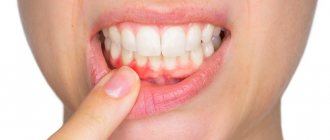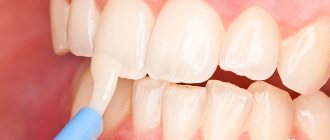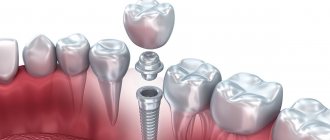Author: Brodsky Sergey Evgenievich Deputy Chief Physician, Candidate of Medical Sciences in the specialties: dentistry and medical microbiology A chipped tooth is a common reason for visiting a dentist. Typically formed as a result of thermal or mechanical trauma. Depending on the nature of the damage and its severity, the dentist selects a method to restore the integrity of the tooth. Failure to contact a specialist in a timely manner, even with a small chipped tooth, can lead to the development of inflammation and other complications.
Ask a question!
8
We'll call you back in 1 minute
Causes of tooth chips
Before choosing a therapeutic method, the dentist determines the cause of chipped teeth. It could be:
- thermal or mechanical injury;
- injury sustained as a result of careless manipulations by the dentist during treatment;
- lack of nutrients due to poor nutrition or strict diets;
- congenital diseases associated with metabolic disorders of calcium, fluoride, calciferol, which are necessary for the strength of teeth;
- intrauterine disruption of enamel formation;
- dental pathologies of an infectious-inflammatory nature;
- sharp changes in hormonal levels, diabetes mellitus, thyroid disease;
- bad habits.
Types of tooth chips and their symptoms
When choosing a treatment method for a chipped tooth, its type is also taken into account. In dental practice, the following forms of chips are distinguished:
- Incomplete chipping is accompanied by cracking of the surface layer of the tooth, while the inner layers do not undergo changes. Such damage is not noticeable to the naked eye.
- A chip of tooth enamel leads to cracking of the surface layer and its slight rejection. This is a small enough chip on the tooth that patients do not notice its appearance.
- A chip of dentin, the hard layer that makes up the base of the tooth. A chipped tooth crown may go unnoticed because it does not cause significant pain. You may experience discomfort while eating or brushing your teeth. Such cracks provide access to vascular and nerve fibers, which increases the likelihood of infection and the development of purulent catarrhal processes. Urgent treatment for a chipped tooth is required.
- A deep chip of a tooth under the gum with exposure of the pulp. Causes severe pain, bleeding, swelling of the gums and increased local temperature. Often accompanied by a chipped tooth root. This type is dangerous, since the likelihood of infection and damage to nerves and blood vessels is greatest.
Causes
- Dental trauma. Falls and impacts are the main reason why chips and cracks occur in perfectly healthy teeth;
- Negligence towards one’s health and bad habits (opening beer bottles with teeth, cracking hard nuts with them, gnawing hard objects, etc.);
- Demineralization of tooth enamel. A process that leads to weakening of enamel and increased risk of injury;
- Carious lesions. They damage the structure of enamel and dentin and thereby make the tooth more vulnerable to mechanical stress. Depulpation completely “kills” the tooth: the tissues, not receiving nutrition from the pulp, become very fragile;
- Bite abnormalities. Cause improper load distribution, which increases pressure on individual teeth or areas of the dentition;
- Incorrect filling. Due to an incorrectly installed filling, the chewing tooth often chips;
- Poor nutrition and poor hygiene. An indirect cause that affects dental health in general;
- Weakened immunity, bad genetics.
What to do if a tooth is chipped?
If the enamel or crown of a tooth is damaged, you should consult a dentist, who will determine the need for treatment and the possibility of restoring the chipped tooth. Before contacting the clinic, it is necessary to prevent the occurrence of infectious processes and the further spread of a chipped tooth below the gum level. For this purpose, dentists at the Partner-Med clinic recommend:
- rinse your mouth with water with added salt and soda or chamomile decoction to remove debris;
- irrigate the oral cavity with a solution of Chlorhexidine or Miramistin;
- apply a cold application to the gum;
- take a pain reliever (Analgin, Ketanov, Ibuprofen) or apply a compress of gauze soaked in Lidocaine or Novocaine to eliminate pain;
- eat only soft and warm foods.
If a large piece has broken off as a result of damage, it must be found, since often with its help and composite materials it is possible to restore a chipped tooth.
Consequences of injuries
Despite following measures at home, a late visit to the doctor can result in some complications:
- infection of the pulp, development of inflammation, severe pain;
- increased tooth sensitivity;
- root fracture, inflammation of periodontal tissues;
- tooth mobility, high risk of loosening and loss;
- violation of the correct closure of the jaws;
- formation of cysts, granulomas as a result of the inflammatory process.
In order to eliminate dangerous consequences, it is important to take an x-ray. If serious violations are detected, the doctor will prescribe treatment and take measures to prevent consequences.
What to do if tooth enamel is chipped?
A chipped front tooth enamel must be restored using a remineralization or fluoridation procedure, which allows you to restore the properties of the surface layer and its integrity. The procedures are carried out in several stages, during which the dentist applies special enriched solutions to the teeth.
A small chip on a front tooth can be restored using light-curing composite materials. The procedure can be performed on the same day you visit the dental clinic.
Just CALL US!
+7
We will answer any of your questions and will definitely help you!
Features of restoration with composites
The essence of composite restoration is the layer-by-layer application of filling materials with high plasticity to eliminate defects, recreate the shape and color of the enamel. Restoration occurs in stages, imitating natural layers. After creating the opaque frame with dentin-tinted composites, a layer is applied that conveys the transparency of the enamel color. Finally, the natural pattern of the tooth is drawn by hand.
The procedure is performed in the dental chair in one visit. Unlike prosthetics with crowns or veneers, there is no need to significantly grind the crown part, take impressions, or wait for the structures to be made.
What to do if a tooth is slightly chipped?
For a chip of moderate severity with partial damage to the dentin, the doctor recommends building up the chipped tooth. During the procedure, composite materials are used to restore a chipped tooth.
Build-up of a chipped tooth can be done on damaged tissues, after careful treatment, or on a pin if there is significant damage and there is no base for build-up. As a rule, implantation of a pin and extension is carried out when a tooth wall is chipped or a back tooth with several roots is chipped.
The most common causes of chipped teeth
Human teeth are very strong. They are well protected from external mechanical influences and are designed specifically to cope with tough, fibrous foods. However, there are many factors that could potentially lead to chipping.
When you make an appointment with your dentist, he or she will conduct a thorough examination of your mouth and determine what may be causing the problem.
Typically, chips occur as a result of several common reasons:
- Inattentive food selection. You can chip a tooth when chewing if there is something too hard inside the food. It could be a small stone, a mollusk shell, and much more. The danger is especially great if you actively chew food and cannot sense in time that something is wrong.
- External trauma. Often happens when hit, fallen, or involved in a traffic accident. There is also a danger of collateral injuries. This may include tooth dislocation, gum damage, wounds on the tongue, or the oral mucosa.
It is also important to understand that the strength of a person's teeth may vary depending on many factors. There are several factors that significantly increase the likelihood of chipping:
- Violation of the acidity of the oral cavity.
- Enamel diseases.
- Cracks on the surface of the tooth.
- Severe damage to the seal.
- Malocclusion and other congenital deformities.
- Bruxism.
People with bad habits are also at risk. Excessive consumption of alcohol and smoking leads to teeth becoming much more fragile.
If a person belongs to a risk group, a chip may appear even from not the strongest pressure. Therefore, it is worth monitoring the condition of your teeth and taking timely measures. So, if you suffer from bruxism and grind your teeth a lot at night, you should choose mouthguards on the advice of your dentist to reduce the negative impact.
Some people also experience chipping simply because they are inattentive to their diet. They actively chew on candy and nuts and open their jaws too much while chewing food, which significantly increases the potential for injury.
Sometimes the problem takes on a systemic nature and indicates negative changes in the body, a lack of certain nutrients from food. In this case, the answer to the question of why teeth may break off specifically in your case is given by a comprehensive examination.
WHY ARE COMPLEX TEETH DONE IN PARTNER-MED?
We know how to work!
We have orthopedic dentists with 8-30 years of experience!
We love to work!
We will give you a free consultation and tell you exactly how best to make your teeth better!
We are responsible for the result!
We work conscientiously and will make your teeth LIKE YOURSELF!
Signs of chipping
In most cases, chips can be identified by visual inspection or when the patient simply touches the tooth with his tongue. But there are also situations when the chip is located on the inside, difficult to reach and difficult to inspect.
Such situations reveal themselves as a whole list of symptoms. These include the following:
- Problems with chewing food, something constantly gets in the way, pieces begin to get stuck inside the tooth.
- The loss of a previously installed filling (a chip forms on the remaining part of the tooth and it simply cannot hold on normally).
- Severe sensitivity when eating - a reaction occurs to sour, salty, cold, hot foods.
- Acute pain and severe pulsation at the site of injury.
It is worth understanding that the size and nature of chips may vary. Because of this, some patients may not even notice the problem, while others experience severe pain - their nerve is exposed. Regardless of the degree of destruction, you should consult a doctor as soon as possible and conduct a detailed examination of the oral cavity.
What to do if your front tooth is severely chipped?
Small chips of the front tooth can be restored on the day of visiting the dentist, however, severe damage involving the pulp requires its removal and treatment of the chipped front tooth. After therapy, canal filling and crown installation are prescribed. In severe cases, tooth extraction is performed and prosthetics are prescribed.
Deputy Chief physician Sergey Evgenievich Brodsky
Sign up for a free consultation
+7
Restoration method - one-stage implantation immediately after root removal
Single-stage implantation of a front tooth involves immediately installing an implant into the socket after tooth extraction. For this type of implantation, special dental implants with aggressive threading and a high degree of primary stabilization are used. On the same day, immediately after implantation, a temporary plastic crown is installed. This implantation allows you to solve two problems - removing a broken tooth root and closing a cosmetic defect. In addition, the method allows you to save a little, because... Some manipulations are not performed (for example, the gum former is not installed).
After 3-4 months, when osseointegration of the implant is complete, permanent crowns are installed. Just as in the case of conventional crowns, from an aesthetic point of view, the best solution for the front teeth is the use of ceramic crowns and, accordingly, abutments. It is preferable to install the crown on a zirconium dioxide abutment, then in any type of lighting the crown will not stand out from the general row of teeth. In our opinion, this option for restoring a broken front tooth is the most optimal.
Cost of restoring a chipped tooth
The cost of restoring a chipped tooth depends on many factors. The Partner-Med clinic has the most reasonable prices in Moscow. Thus, the price of restoring a front tooth using veneers starts from 15,900 rubles, the cost of a crown starts from 7,000 rubles, and filling will cost 2,400 rubles.
The Partner-Med clinic employs only qualified specialists who will help you choose the most optimal method of treating chipped teeth at an affordable price. We can install veneers, crowns, implants made from high-quality materials, and a tooth restored using artistic restoration, if the dentist’s recommendations are followed, will last for decades.
Request a call back or dial our number!
+7
This phone call does not obligate you to anything. Just give us a chance and we will help you!
Just pick up the phone and call us!
+7
We will definitely make you an offer that you cannot refuse!
Restoration of injured central incisors in children
Injuries to the anterior teeth of the upper jaw are a common occurrence in children. There are several ways to treat this problem. The consequences of this type of injury can vary from a simple crack to complete avulsion of the tooth. It depends on the severity and nature of the injury. Causes of injury may include playground incidents, fights, or falls. In modern aesthetic dentistry, restorations of the anterior teeth cause the greatest difficulties.
There are several ways to treat and restore chipped front teeth. The choice depends on the dentist's point of view and his knowledge in the field of aesthetic dentistry. In recent years, significant progress has been made in the field of aesthetics and physical properties of composite materials.
Thanks to this, as well as improved techniques such as layering techniques, dentists are now able to imitate the natural appearance of the dentition with direct esthetic restorations. A wide range of enamel shades has also been created, giving dentists the ability to control the degree of translucency and opacity of these types of restorations during minimally invasive procedures. The preserved tooth fragment can be used for its restoration. In this case, a good aesthetic result is achieved.
Today, dentists can perform restorations and achieve aesthetic results using bonding techniques. If the crack is close to the pulp or the pulp is exposed, the dentist may perform endodontic treatment followed by the installation of a post and crown. You may opt for pulp capping with a crown, porcelain veneer, or direct composite restoration.
In children aged 7-8 years with mixed dentition, large pulp canals with open apices are often found. This is explained by the incompleteness of the development of the dentition. At this stage, the occlusal plane, as well as the position of the teeth and soft tissues, are unstable. They are at the stage of formation. Once completed, it is expected that ideal treatment can be carried out. Age is an important factor in choosing the optimal restoration method. If options exist, children should be treated conservatively until they reach an appropriate age.
Clinical case 1.
The patient, a 7-year-old boy, chipped one third of his incisor as a result of a fall (Figure 1). The father took the child to the family dentist. The treatment plan he proposed seemed overly aggressive to the man (as a child, he had a negative experience of dental treatment for a similar injury). Given his son's age, the man felt a more conservative approach was best. Father and son were referred to my clinic for consultation. The man provided one x-ray, as well as a chipped fragment of the 9th tooth in a plastic bag.
Photo 1. Photo before surgery
Photo 2. Smile before surgery, chipped 9th tooth.
Diagnostics.
Clinical examination and review of one periapical radiograph revealed no pulp exposure. A diastema was observed between teeth 8 and 9, with tooth 9 tilted towards the buccal surface. An examination of the bite revealed the absence of occlusal contacts between the anterior teeth of the upper and lower jaw. The final position of the teeth, bite plane and soft tissues have not yet formed. Therefore, treatment options have been limited to the most conservative, minimally invasive procedures. After examining and cleaning the fragment, it was installed in place. Checked compatibility. To stabilize the fragment while the bond formed, a mastic stent with vinyl polysiloxane was made (Photo 3).
Photo 3. Checking the compatibility of the fragment.
After taking scans and photographs, taking into account the age of the child, his father was offered the following treatment options:
* Restoration of a chipped tooth using a light-curing composite
* Making a ceramic veneer (at this age this method is not recommended due to the changing size of the tooth and the development of soft tissues)
* Reattachment of tooth fragment
Treatment plan.
Due to the absence of symptoms, treatment was started without anesthesia. The dentin of the tooth and the fragment was cleaned with pumice, washed and dried. The tooth and fragment were disinfected in a surgical scrub with 2% chlorhexidine gluconate for 60 seconds. They were then washed, placed in a 5% sodium hypochloride solution and washed again.
After this procedure, the surgical field was isolated with cotton swabs. To increase bond strength and minimize microleakage, a full etching technique was used. The dentin and enamel surfaces of the chip and tooth were etched separately for 15 seconds using Ultra-Etch (Ultradent; South Jordan, UT) 35% with phosphoric acid (Ultradent), rinsed, then dentin primer and adhesive (ClearFil SE Bond) were applied J. Morita; Irvine, California), thinned with a blower and light cured for 15 seconds. To stabilize the position of the fragment while the bond was being formed, a stent was placed on the lingual surface of the tooth. The liner and dual-cure composite activator (Insure, Cosmedent; Chicago, IL) were then mixed and a small amount applied to both surfaces. The fragment was put in place. Excess composite was removed using a brush. Photopolymerization was carried out for 30 seconds. The stent was carefully removed; the lingual surface was cured for 30 seconds; this was followed by facial and lingual curing for 60 seconds.
The effects of trauma to the front teeth can range from simple cracking to complete avulsion, depending on the severity and nature of the injury. To increase the bond strength and durability of these types of restorations in children, it is recommended to apply excess composite along the fracture line. In this case, as mentioned earlier, due to the lack of occlusal contact between the maxillary and mandibular anterior teeth, a layer of hybrid composite was applied a few millimeters above the fracture line towards the lingual edge of the incisor, followed by light curing. A thin layer of light-curing clear composite was applied to the facial fracture line (Figure 4).
Photo 4. The fragment after bonding.
Grinding and polishing.
To ensure natural anatomy and structure of the tooth, a transparent composite was applied to its facial surface. Natural gloss on the facial and lingual surfaces of the teeth was provided by polishing strips. Flexi Disks (Cosmedent) followed by composite polishing paste were used to polish the face surface. Ball-shaped finishing diamond burs (Brasseler; Savannah, GA) were used on the lingual surface to create the desired structure. Finishing discs (Cosmedent) were then used followed by the application of a composite polishing paste. Occlusion was checked using various jaw movements to correct unstable contacts. The result was extremely satisfactory for the patient and his parents. The patient was scheduled for a postoperative visit within a few weeks (Figure 5).
Photo 5. View after treatment.
Clinical case 2.
This 11-year-old boy came to the clinic with his mother for the restoration of one third of the 9th tooth (Photo 6). The cause of the injury was a fall in the shower. Unlike the first case, the fragment of tooth 9 was lost. The patient's mother's request was high-quality conservative restorative treatment to restore the teeth to their natural appearance. Thanks to the improvement of the composition of modern composite materials, clinicians have at their disposal a variety of shades that can be used to create aesthetic restorations.
Photo 6. Case 2, view before surgery, chipped tooth 9. The fragment is lost.
Photo 7. Case 2, view of the smile before surgery, chipped tooth 9.
Diagnostics.
Clinical examination revealed no signs or symptoms of TMJ syndrome or malocclusion. Radiographs and clinical examination revealed no pulp pathologies. A diastema with minimal restoration was observed between teeth 8 and 9. There were no signs of a fracture of the 8th tooth.
Treatment plan.
After a complete clinical examination, an alginate impression was made, from which a study model was made for a diagnostic wax-up. Due to the loss of the fragment, the patient was offered a composite restoration. Considering the boy’s age, restoring teeth with ceramic veneers was not the best option. The patient's parents approved the proposed treatment option.
Before restoration, the tooth was cleaned with pumice and disinfected with chlorhexidine. Then we selected shades of Renamel Microfil composite (Cosmedent) and a hybrid composite to restore enamel and dentin. For the initial preparation, a round-head diamond bur (Brasseler) was used with a 2-mm lingual reduction with a deep and long bevel of 2-3 mm along the borders of the facial and lingual surfaces. To increase adhesion strength and minimize microleakage, complete etching was performed. The labial and lingual surfaces were etched for 15 seconds with 37% phosphoric acid, followed by 10 seconds of rinsing and drying. Clearfil SE-BOND adhesive (Kurary America, New York, NY) was applied to the facial and lingual surfaces. The material was then air thinned and light cured according to the manufacturer's instructions. To restore the lost fragment, a three-increment technique (dentin-enamel-incisor [Cosmedent]) was used. Renamel hybrid composite shade B1 was used to restore the lingual wall. To cover the edge of the bevel, a thin layer of opaque material was applied, followed by light curing.
Photo 8. Restoration of chipped tooth 9 with a composite material with microfiller.
Microfilled composite shade B1 was applied to the entire surface of the composite and tooth. An IPC spatula (Cosmedent) was used to create a random bevel and groove for the incisal composite. Then light curing was carried out. The groove is moistened using the composite, and compaction is carried out to ensure incisal transparency. Next comes curing.
Grinding and polishing.
The surface texture and final shape and function of the restoration are achieved through careful grinding and polishing. In this case, discs, crowns and contacts were used separately. Final polishing was carried out using a composite polishing paste (Cosmedent). The finished restoration looked like a real tooth (Photo 9).
Photo 9. Enlarged view of the finished restoration.
Conclusion.
Provided that the fragment is preserved and its integrity, it is possible to bond a chipped front tooth of the upper jaw with excellent results. In a short time, the fragment can be disinfected and secured in place using a dual-cure composite (Case 1). In cases of chip loss where a significant portion of the tooth is intact, conservative restorative treatment with direct esthetic composite as described in Case 2 is possible and is usually an excellent option for young patients (Figures 10 and 11).
Photo 10. View after surgery.
Photo 11. View after surgery.
Author: Khalil S. Saghezhi, DDS
What complications can you encounter due to chips?
If you notice a chip on your tooth, you should contact your dentist as soon as possible to have it repaired. And it's not just about aesthetics. Delay will cost the health of your smile. There are several potential complications that have to be encountered in medical practice:
- Tooth infection. Any pathogenic bacteria can penetrate through the open pulp. As a result, the person not only suffers from pain. Previously, only a slightly damaged tooth that could still be saved had to be removed.
- Periodontitis. This is the name of a strong inflammatory process that occurs in the tissues surrounding the apex of the tooth root. Treatment is long and complex and may require removal.
- Formation of neoplasm. They can be of either granulosa or cystic type and pose a serious danger to the human body.
- Changes in bite and dental mobility. It is formed due to the fact that it becomes inconvenient for a person to close his jaws. There are many types of complications due to this reason.
The development of severe sensitivity to food, which over time develops into pain, is also characteristic. You cannot delay treatment - contact a doctor as soon as possible.








